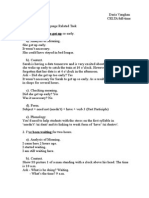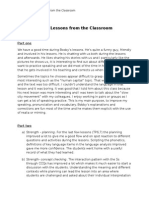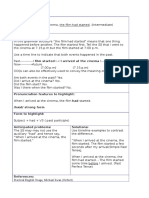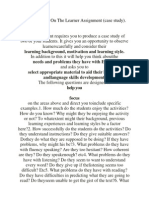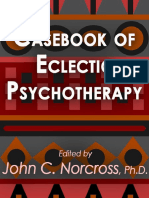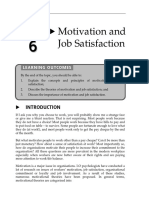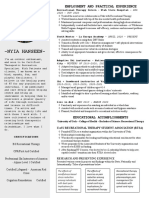CELTA - Assignment 2
CELTA - Assignment 2
Uploaded by
vligrCopyright:
Available Formats
CELTA - Assignment 2
CELTA - Assignment 2
Uploaded by
vligrOriginal Description:
Copyright
Available Formats
Share this document
Did you find this document useful?
Is this content inappropriate?
Copyright:
Available Formats
CELTA - Assignment 2
CELTA - Assignment 2
Uploaded by
vligrCopyright:
Available Formats
Name: Bobby (Vlad Grigoras) Assignment 2
26/5/2015
\\saasdasd
Assignment 2: Focus on the Learner & Skills-related Tasks
Part 1: Background Level Elementary max attendance 13 Ss
a) Summary:
Age range: 11 Ss - 18-24 years old; 1 30-34; 1 over 39
The Elementary class has about 10 to 13 students who attend the English
course on a daily basis. Their overall level of English language knowledge
varies depending on their previous learning experiences. This generates
quite a big gap between the students placed at the bottom where some of
them have difficulties in speaking and understanding English, and the top
learners who possess varied vocabulary for this level.
Previous learning experiences are varying from one to three months (3
students) to 2 years or more (4 students). Another 3 students in the class
learned English for 6 months to 1 year, while 1 student has an experience of
1-2 years studying English.
The interests vary from learner to learner as we go through the analysis of
the collected data. Most of the students, 8 out of 11, are interested in
studying English to ease their communication with other English speakers.
The group underlined their interest to watching movies and listening to
music (6 students), or learn new topics in universities (6 students). It is not
very useful for the group to practice their reading, but 8 students found it
useful.
The main motivation is outlined in the students main interest, but a more
accurate fact is found in the students notes. These highlight their motivation
to communicate in English (4 answers), to find a job, study or for business
purposes (6 answers), while for travelling only two students expressed their
motivation.
Learner styles. Based on the collected data, most Ss in this class are good
visual, audial and kinesthetic learners as they successfully engage in
activities after interacting with images/visual explanations, when they
Name: Bobby (Vlad Grigoras) Assignment 2
26/5/2015
\\saasdasd
engage in listening and speaking activities, or when working around the class
(eg: board rush). Students in the class want to find out more about the
teachers and their culture. The class made a good progress during the past
two weeks to get involved in group and teacher-student discussions.
Preferred activities. The learners in this class have a particular preference for
speaking activities (10 Ss) and especially working in groups (9 Ss), pairs (10
Ss) or together with the whole class (7 Ss). It is clear that most of them (7
Ss) are not happy when they must work alone. Their preference for writing
and worksheets is mediocre.
b) Groups ability with productive skills:
There are about 4-5 students who are clear and precise in their speaking and
writing activities. The other 8-9 students struggle when they try to form
longer sentences so they need a lot of support in their handouts/instructions.
c) Groups ability with receptive skills:
Yan, My, Quoc and Tram are the most active and strong students in the
listening and reading classes. Their feedback in productive skills tasks is
quick and concise, but they still need to listen two times to the material, or
read through. At the other end I want to emphasize that Dat and Hanh need
more support when dealing with these tasks. On an overall scale, the gap
between these learners is quite high and divides them into separate
categories, but brings in the stronger students who lead and inspire the
weaker ones.
Part 2: Identifying language needs:
Grammar: Dat Van Tien + class
What the student wrote:
I feel bored when I speaking. T
What is wrong:
Wrong form of the tense present continuous.
Incomplete sentence, missing the auxiliary verb
to be in its form I am/Im speaking.
Why did the student
Misunderstanding of the verb be and its use in
Name: Bobby (Vlad Grigoras) Assignment 2
26/5/2015
\\saasdasd
make the mistake:
this context. The mistake might occur due to the
differences between Vietnamese grammar rules
and English grammar. This is a developmental
error among most of the students due to their L1
acquisition.
Pronunciation. Dat + class
What the student said:
Buses /s/
What is wrong:
Pronunciation of /s/ instead of /z/.
Why did the student
make the mistake:
This has been a common mistake during all
classes for most of the students and particularly
for Dat. It seems challenging for the Ss to
pronounce the sound /z/ when it is quite
uncommon in the Vietnamese language phonetics.
This amounts to transfer of structure errors from
L1. On some occasions students dont even
articulate the /s/, /z/ sounds at the end of the
word.
Eg: buses, classes, lessons, texts.
Part 3: Helping the learner:
Activity 1 - to be auxiliary in present continuous
For the elementary students the desired activity to understand present
continuous to be + ing is a productive exercise followed by self-correction
and reading. The students respond well when asked to fill the gaps in pairs,
and afterwards test their writing at the WB to check their understanding of
form. The learners engage very well when they write and read in a group.
The correction will be made at the board by the whole class together with the
teacher (where necessary).
This particular activity is an entertaining miming activity designed to engage
the students and enhance their receptivity of use, meaning and form through
a TPR activity and guided discovery.
Name: Bobby (Vlad Grigoras) Assignment 2
26/5/2015
\\saasdasd
When I thought about this activity I considered the learners motivation to
improve his comprehension of English language and interest for
communication activities. The aim of the exercise is sedimentation of a solid
foundation which emphasizes the meaning and form of speech. This is a
common trait for the whole class when it comes to their interest and needs.
Activity 2 - /s/ vs /z/
This particular elementary group of students is interested into learning
English for conversational purposes so proper pronunciation is a cornerstone
for their English lessons. This activity applies to particular learners such as
Dat, but in the same way applies to all elementary learners in the group.
Their learning styles are varied so the response to audial activities gives the
Ss a good practice for emphasizing the pronunciation variations of /s/ and /z/
sounds. In the following activity the learners will watch and listen to a short
video1 about Green economy in Europe. They will write down all words
pronounced with a /z/ sound on the first listening, and words with a /s/ sound
on the second listening. Pronunciation practice is the last drill of the activity
where the involvement aims the whole group, boys/girls, and pairs.
Besides the fact that the topic is interesting and practical, the language is
simple and clear so the elementary learners can benefit of acquisition of new
vocabulary too, and/or understand the context to use their automated
knowledge. Their vocabulary is consistent for this stage, but is unexploited
and rarely challenged properly.
Part 4: Choosing material
In order to generate context for the learners I propose an engaging topic to
get their interest Independence Day in Romania. The material is both easy
to comprehend but also compelling for the students. Their level of
engagement in activities which involve new information about different
countries or cultures triggers a self-challenging attitude towards the tasks.
The learners cooperative style will make it easy for them to work in pairs
1 https://www.youtube.com/watch?v=tIgMRYJuKnY
Name: Bobby (Vlad Grigoras) Assignment 2
26/5/2015
\\saasdasd
and groups on this material. This might trigger negotiation between them,
leading to speaking practice and discussions.
The material2 used for the following tasks is an online article about the
Romanian unification day which is similar to the events the Vietnamese
celebrate (activate schemata). By these means the students will learn useful
vocabulary items for conversations about their country, history, and culture.
The teacher truncated the text and he will use it for both reading and
speaking tasks. (Material attached in the appendix 2)
Part 5: Designing receptive skills tasks reading aim: practice reading for
gist and skimming
The students in the class comprehend new vocabulary and they can
understand the context with the help of their actual knowledge. This gist task
will not require the students attention for details or broad lexical knowledge.
By simply understanding the context they can easily acquire new vocabulary
from the text. I underline here the idea of challenging the students: in order
to make students better readers, we need first of all to raise their awareness
that its not always essential to understand every word, and that practicing
some different reading techniques in English may be very useful to them.3
The design of this particular gist task is to generate prediction and interest
for the material. First of all the T will give the Ss the title and ask them to
discuss in pairs and predict what the text is about. Afterwards they will go
through skimming to get a general understanding of the text. The T instructs
the Ss to read fast in two min.
It is common when engaging the Ss in intensive reading to have the curiosity
of finding out the meaning of each word. During these activities the Ss will
receive specific instructions about reading strategy and time on tasks. On
the second reading they will have more time for exploiting the meaning of
the text and answering the questions. Ss will be encouraged to use their
dictionaries.
2 http://www.romania-insider.com/what-do-romanians-celebrate-on-their-december-1stnational-day/110558/
3 Learning teaching by Jim Scrivener, Heinemann 2010, p184
Name: Bobby (Vlad Grigoras) Assignment 2
26/5/2015
\\saasdasd
Next Ss will engage in a scanning activity. This involves searching for
information getting involved with details of the text. In this way the learners
will read to extract specific information. While the students read through the
text they will identify certain unfamiliar vocabulary. This can lead to a
discussion after the second task and checking understanding of meaning as
a secondary aim of the reading activity.
As I mentioned in the first paragraph, the idea of challenging the students
with a slightly more difficult text then they are used to, will further motivate
to engage themselves into a constant practice of improving their language
skills. In this class the students look supportive when it comes to working in
pairs/groups which is inspiring in the process of English learning. These facts
are determinant for their language development. It is important for these
students to expand their vocabulary and to do so by introducing them to
varied materials, as a mean to provide understanding of meaning and use of
English language.
Part 6: Designing a productive skills task speaking aim: practice
pronunciation, language processing.
As I already indicated in the above paragraphs, this group of learners is
motivated and willing to learn English as a communication tool mainly.
Subsequent to the previous reading, the students will engage in a speaking
activity with the main topic independence/unification day. In this way the
context is ready generated through the reading material and reading tasks.
To keep the learners engaged and challenged, the speaking activity will be
about Independence Day in Vietnam.
The speaking activity breaks down into two parts. For the first part of the
activity the teacher introduces the discussion topic Independence Day in
Vietnam. An image from an Independence Day celebration will be shown on
the IWB. The students will go through group brainstorming process to
arrange their knowledge of Independence Day. Working in pairs, the students
will write down and discuss their main ideas about the Independence Day in
Vietnam. In this way, all learners, even the weaker ones, get into discussions
with their partners. During the activity the teacher will monitor and
encourage involvement of all participants. At the end of the brainstorming,
the teacher will entertain a class discussion.
Name: Bobby (Vlad Grigoras) Assignment 2
26/5/2015
\\saasdasd
Any speaking activity for this group of learners is designated to inspire
confidence and fluency. In this way the students will have the opportunity to
try out their language.
In the second activity of the task the students are invited in front of the class
for a speed dating activity through which they will ask each other about their
Independence Day experiences. They will change partners after each 2
minutes. Again the teacher will monitor and take notes for the feedback
session after the activity.
Bibliography:
1. Learning teaching by Jim Scrivener, Heinemann 2010
2. http://busyteacher.org/classroom_activities-grammar-worksheets/
3. http://www.slideshare.net/MelissaFerrer/learner-errors-and-erroranalysis
Materials:
http://www.teach-this.com
https://www.youtube.com/watch?v=tIgMRYJuKnY
http://www.romania-insider.com/what-do-romanians-celebrate-on-theirdecember-1st-national-day/110558/
You might also like
- CH01 Managing: A Competency Based Approach, Hellriegel & JacksonDocument30 pagesCH01 Managing: A Competency Based Approach, Hellriegel & Jacksonsweetyraj89% (9)
- CELTA Online Unit 2 Task 13 - Designing TasksDocument2 pagesCELTA Online Unit 2 Task 13 - Designing TasksShalindriNo ratings yet
- CELTA. Assignment 3Document7 pagesCELTA. Assignment 3Mehdi RoostapourNo ratings yet
- Celta: Assignment 3: Skills-Related: Part 2: Receptive Skill Task DesignDocument3 pagesCelta: Assignment 3: Skills-Related: Part 2: Receptive Skill Task DesignBasma Elzeidy100% (1)
- Language Related Tasks Assignment C6 2017Document2 pagesLanguage Related Tasks Assignment C6 2017Imran Rahim0% (2)
- Celta Language TaskDocument4 pagesCelta Language TaskDariaVaughan100% (3)
- Assignment 2 - Maria - Marked PDFDocument10 pagesAssignment 2 - Maria - Marked PDFMaria AvilovaNo ratings yet
- CELTA Assignment 1Document8 pagesCELTA Assignment 1Ítalo Coutinho100% (1)
- Ass2-Language Related TaskDocument29 pagesAss2-Language Related TaskГалина Рогожина50% (2)
- Assignment - Language Related TasksDocument5 pagesAssignment - Language Related TasksJulie LhnrNo ratings yet
- CELTA Assignment 3: Language-Related SkillsDocument8 pagesCELTA Assignment 3: Language-Related Skills居然100% (2)
- Language Related TaskDocument10 pagesLanguage Related TaskCheryl ZhuNo ratings yet
- Focus On The Learner: CELTA - Written Assignment 1Document6 pagesFocus On The Learner: CELTA - Written Assignment 1Cira Fernandez SanchezNo ratings yet
- Assignment 3 - LSRT Skills E - TippingDocument8 pagesAssignment 3 - LSRT Skills E - Tippingbrentcullen50% (2)
- Assignment 2 Siwar - 2020Document14 pagesAssignment 2 Siwar - 2020Siwar Bdioui100% (1)
- Assignment 2 - Language Analysis and MeaningDocument9 pagesAssignment 2 - Language Analysis and MeaningShelia83% (6)
- CELTA Assignment 2 Feedback Language RelDocument9 pagesCELTA Assignment 2 Feedback Language RelRania MohammedNo ratings yet
- CELTA Assignment 3 SkillsDocument16 pagesCELTA Assignment 3 SkillsMARCELA100% (1)
- Assignment 3 Language Skills Related TasksDocument2 pagesAssignment 3 Language Skills Related Taskssweetlankka0% (2)
- CELTA Assignment 1Document10 pagesCELTA Assignment 1Thomas100% (4)
- The The 6 Principles for Exemplary Teaching of English Learners: Young Learners in a Multilingual WorldFrom EverandThe The 6 Principles for Exemplary Teaching of English Learners: Young Learners in a Multilingual WorldNo ratings yet
- Assignment 4 CELTADocument3 pagesAssignment 4 CELTAvligr67% (9)
- Clairsentient Awakening FinalDocument27 pagesClairsentient Awakening FinalAnonymous 7R6n0f9BY91% (11)
- Adorno, 'The Actuality of Philosophy' (1931 1977 Telos Ed)Document11 pagesAdorno, 'The Actuality of Philosophy' (1931 1977 Telos Ed)pro_use100% (1)
- Celta Assignment SampleDocument3 pagesCelta Assignment SampleСветлана Кузнецова100% (1)
- CELTA Language Related Assignment (New)Document8 pagesCELTA Language Related Assignment (New)Khalid MehmoodNo ratings yet
- Language Related Task CELTA CourseDocument2 pagesLanguage Related Task CELTA CourseIvano Celentano50% (2)
- Assignment 3 SathyaDocument10 pagesAssignment 3 SathyaSathya HarikumarNo ratings yet
- LRT FinalDocument28 pagesLRT FinalÆrikïrÆKǎwǎè100% (2)
- 4 TH AssignmentDocument5 pages4 TH AssignmentWagner Felix0% (1)
- CELTA Assignment 3 Language Skills RelatDocument4 pagesCELTA Assignment 3 Language Skills RelatIosif DraganNo ratings yet
- Assignment 3 LSRT - MiguelLaricoCondori - To CompleteDocument12 pagesAssignment 3 LSRT - MiguelLaricoCondori - To CompleteMIGUEL ANGEL LARICO CONDORINo ratings yet
- Assignment 1 - LRTDocument5 pagesAssignment 1 - LRTSinzi SocolNo ratings yet
- CELTA Written Assignment: Focus On The Learner-EXAMPLEDocument4 pagesCELTA Written Assignment: Focus On The Learner-EXAMPLEClara Maria Quispe CéspedesNo ratings yet
- Assignment 2 - Language Related Tasks - 2Document2 pagesAssignment 2 - Language Related Tasks - 2SamNo ratings yet
- FOL AssignmentDocument8 pagesFOL AssignmentRuby AlNo ratings yet
- Written Assignment 2: Language Related Tasks: Example 2 in The Example Answers Below The Text)Document5 pagesWritten Assignment 2: Language Related Tasks: Example 2 in The Example Answers Below The Text)Maria AvilovaNo ratings yet
- Focus On The LearnerDocument7 pagesFocus On The LearnerDiana Graur100% (2)
- CELTA Assignment 1Document5 pagesCELTA Assignment 1magnolia_moog100% (2)
- Lesson From The ClassroomDocument4 pagesLesson From The ClassroomCheryl Zhu100% (1)
- Assignment 4Document6 pagesAssignment 4Tom McDonald100% (4)
- Celta Lesson PlanDocument2 pagesCelta Lesson PlanErgun BeygoNo ratings yet
- Focus On The LearnerDocument5 pagesFocus On The LearnerMumtaz Ahmad100% (1)
- CELTA Assignment 4 RubricDocument6 pagesCELTA Assignment 4 RubricPulkit Vasudha100% (2)
- Assignment 1 - FOLDocument7 pagesAssignment 1 - FOLVan LeNo ratings yet
- Skills Related AssignmentDocument5 pagesSkills Related AssignmentMumtaz Ahmad100% (6)
- A1 Language Related TaskDocument9 pagesA1 Language Related TaskRoger WhittemoreNo ratings yet
- Celta 3Document6 pagesCelta 3yas2456100% (1)
- TP4 Miriam Heskin Speaking & ListeningDocument12 pagesTP4 Miriam Heskin Speaking & ListeningRobertMcCaulNo ratings yet
- Dokumen - Tips Celta Assignment 3 SkillsDocument15 pagesDokumen - Tips Celta Assignment 3 SkillsPriyanshu SharmaNo ratings yet
- CELTA TP Lesson Plan 9Document6 pagesCELTA TP Lesson Plan 9Victor Piedade100% (1)
- CELTA Assignment2 DanilDocument11 pagesCELTA Assignment2 Danilcontrabanded67% (6)
- Assignment 1 Focus On LearnerDocument6 pagesAssignment 1 Focus On LearnerDuaa100% (1)
- CELTA Lesson Plan No. 1Document4 pagesCELTA Lesson Plan No. 1Jayan Nair100% (1)
- Assignment 4 LFCDocument3 pagesAssignment 4 LFCSarshNo ratings yet
- CELTA Lesson PlanDocument8 pagesCELTA Lesson PlanKateNo ratings yet
- Celta - Assignment 1Document6 pagesCelta - Assignment 1Dainius Šileika0% (1)
- Focus On The Learner: CELTA - Written Assignment 1Document6 pagesFocus On The Learner: CELTA - Written Assignment 1Letícia IglesiasNo ratings yet
- Assignment 1 CELTADocument5 pagesAssignment 1 CELTAvligrNo ratings yet
- Celta Assignment 3Document3 pagesCelta Assignment 3billybobbenjamin75% (4)
- Celta AssignmentDocument13 pagesCelta Assignmentshilpadub100% (2)
- Timisoara Real EstateDocument2 pagesTimisoara Real EstatevligrNo ratings yet
- Assignment 1 CELTADocument5 pagesAssignment 1 CELTAvligrNo ratings yet
- The 7 Natural LawsDocument16 pagesThe 7 Natural Lawsvligr100% (2)
- The 7 Natural LawsDocument16 pagesThe 7 Natural Lawsvligr100% (2)
- Diseases in LettuceDocument17 pagesDiseases in LettucevligrNo ratings yet
- Interview Prep 1 - AIRSWIFTDocument2 pagesInterview Prep 1 - AIRSWIFTDanilo FornaroNo ratings yet
- Research Methodology: An Introduction: K.BalajiDocument17 pagesResearch Methodology: An Introduction: K.BalajiUttam Kumar SahooNo ratings yet
- COMM200 Public Speaking Speech 3 OutlineDocument2 pagesCOMM200 Public Speaking Speech 3 OutlineRoland PennyNo ratings yet
- Contributions To The Phenomenology of Dreams: Essay 28Document8 pagesContributions To The Phenomenology of Dreams: Essay 28Oliver Medina Oliver MedinaNo ratings yet
- Chapter Four: The Emergence of Thought and Language: Cognitive Development in Infancy and Early ChildhoodDocument39 pagesChapter Four: The Emergence of Thought and Language: Cognitive Development in Infancy and Early ChildhoodHsieh Yun JuNo ratings yet
- Reading Lesson Plan 2Document7 pagesReading Lesson Plan 2dcbarrow100% (1)
- Edward Tolman's Purposive Behaviorism TheoryDocument3 pagesEdward Tolman's Purposive Behaviorism TheoryAngelica Lyca GonzalesNo ratings yet
- Filipino CultureDocument15 pagesFilipino CultureBryan PachecoNo ratings yet
- Twenty Tips For IELTS SuccessDocument2 pagesTwenty Tips For IELTS SuccessIbn E BatootaNo ratings yet
- Critical Analysis of Quantitative and Qualitative ResearchDocument3 pagesCritical Analysis of Quantitative and Qualitative ResearchWyethBeltranDeLeonNo ratings yet
- Oc 2Document3 pagesOc 2Aiza San Pedro SantosNo ratings yet
- Reflection Intervieuw QuestionsDocument7 pagesReflection Intervieuw Questionsapi-431335551No ratings yet
- Casebook of Eclectic PsychotherapyDocument1,004 pagesCasebook of Eclectic PsychotherapyJunard Balangitao Pabas100% (7)
- A Study On Employee SatisfactionDocument97 pagesA Study On Employee SatisfactionAvinash Joseph0% (1)
- Beavers Et Al - 2017 - Fostering Critical and Reflective Thinking in An Authentic Learning SituationDocument17 pagesBeavers Et Al - 2017 - Fostering Critical and Reflective Thinking in An Authentic Learning SituationLALALANo ratings yet
- Teori Fraud DiamondDocument2 pagesTeori Fraud DiamondCitraNo ratings yet
- Motivation Chapter 6Document26 pagesMotivation Chapter 6Anonymous HK3LyOqR2gNo ratings yet
- MYP Command TermsDocument3 pagesMYP Command TermsLennoxMeldrumNo ratings yet
- Beauty and CinemaDocument33 pagesBeauty and CinemaFidel NamisiNo ratings yet
- ReconstructionismDocument3 pagesReconstructionismDimphna Jel Pacifico100% (1)
- Activity 1Document3 pagesActivity 1nulllllNo ratings yet
- Kristen PetersDocument1 pageKristen PetersricNo ratings yet
- Effective Skill Development: How Should Athletes' Skills Be Developed?Document35 pagesEffective Skill Development: How Should Athletes' Skills Be Developed?Dhiraj PathakNo ratings yet
- CV-Huda Al-Khalaileh 2011Document2 pagesCV-Huda Al-Khalaileh 2011Huda AlkhalailehNo ratings yet
- Instructional Module in MIL12 Lesson 9Document2 pagesInstructional Module in MIL12 Lesson 9Daneya Enrica JoseNo ratings yet
- International Journal of Education and Research Vol. 4 No. 6 June 2016Document14 pagesInternational Journal of Education and Research Vol. 4 No. 6 June 2016Trisna YulinaNo ratings yet
- Resume Nov2020Document1 pageResume Nov2020api-383817161No ratings yet





